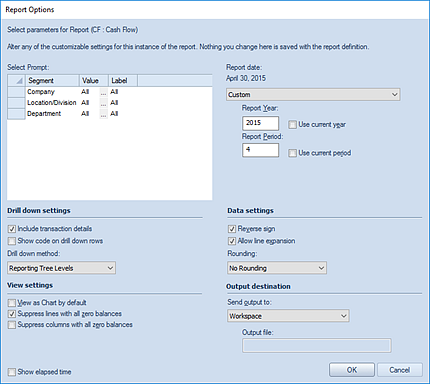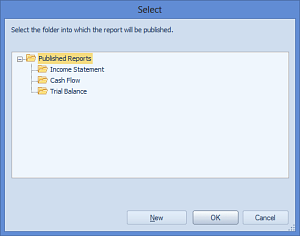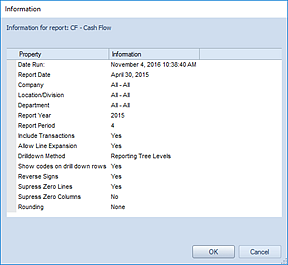
When a report is executed in standard row-and-column format, the report will be rendered in the Report View workspace and the Report View context ribbon will activate for the report.

Features on this ribbon are grouped logically in sections including:
•Configuration – This section contains the report configuration options to manage the Line, Column and Report Definitions that make up your report. The Open All option will open the associated sets with a single click on the selection.
•Drill Down – This section contains the option to change the drill down order for the report.
•Display – This section contains the options to display the report in a chart or graph format, to elect to show hidden columns or lines or to re-open a report which has be run. The option to toggle between “hidden” lines or columns is determined by the option setting in the Suppress field in the Line Definition or Column Definition.
The “Show Adjustment Flags” checkbox allows you to toggle showing or not showing Balancing Adjustment indicators on your report in Report View. This option will only be available if you have defined Balancing Adjustments in your Line Definition.
The Re-open Report option allows you to re-run the report using different report parameters. You can choose to re-execute the report for any change to the available Report Options, such as Segment selections, Report Date options, Drill down method, Rounding options, etc.

The report will run in the Reports Workspace in addition to the report which was just executed. For more information, refer to the section on Report Run Time Options.
•Output - This section contains the options output your report to various sources:
The Publish option allows you to Publish Reports to preserve the report in its current state based on the parameters and data for which the report was executed.

The Export to Excel option allows you to export your report directly to Excel. When the Export to Excel option is selected, when you run your report, you will be provided with a default file name corresponding to your Prospero report file. (You can also enter a new name for your Excel worksheet. Invalid characters in filenames are: \ / : * ? " < > | If you enter these characters, they will be replaced with an underscore.)
After specifying the location and name, select the Save button and your report will open in Excel as it appears in Prospero. All Prospero report formatting options - font type, size, alignment, colors and borders – as defined in the Line, Column or Report Definitions will carry over to your Excel export.
Note: The Export to Excel option will not export any hidden rows or columns specified in your Line or Column Definitions. In addition, formulas in those elements will also not be exported from Prospero. Your report in Excel is a data values and basic formatting export only. For more information refer to Exporting Workspace Reports.
The Export to PDF option allows you to export your report directly to a PDF file. When the Export to PDF option is selected, when you run your report, you will be provided with a default file name corresponding to your Prospero report file. (You can also enter a new name for your PDF worksheet. Invalid characters in filenames are: \ / : * ? " < > | If you enter these characters, they will be replaced with an underscore.)
After specifying the location and name, select the Save button and your report will open in a PDF document as it appears in Prospero. All Prospero report formatting options - font type, size, alignment, colors and borders – as defined in the Line, Column or Report Definitions will carry over to your document.
•Information – This option returns a report information dialog including information such as when the report was run, the report date and parameters, report year and period, as well as other execution options and settings.
